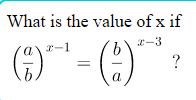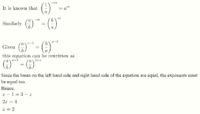You are using an out of date browser. It may not display this or other websites correctly.
You should upgrade or use an alternative browser.
You should upgrade or use an alternative browser.
Can't figure out what i am doing wrong - Laws of exponent
- Thread starter Unit_02
- Start date
Harry_the_cat
Elite Member
- Joined
- Mar 16, 2016
- Messages
- 3,784
Basically you have shown that the statement is true if a=b. That is, if a=b, then x can be anything.
That makes sense! Because if a=b then a/b = 1 and b/a = 1 and it's true that 1^(x-1) = 1^(3-x) for any value of x.
So, if a=b, x can be anything. But if a\(\displaystyle \neq\)b, then x=2.
That makes sense! Because if a=b then a/b = 1 and b/a = 1 and it's true that 1^(x-1) = 1^(3-x) for any value of x.
So, if a=b, x can be anything. But if a\(\displaystyle \neq\)b, then x=2.
Basically you have shown that the statement is true if a=b. That is, if a=b, then x can be anything.
That makes sense! Because if a=b then a/b = 1 and b/a = 1 and it's true that 1^(x-1) = 1^(3-x) for any value of x.
So, if a=b, x can be anything. But if a\(\displaystyle \neq\)b, then x=2.
I see my mistake now. But at first sight i couldn't tell if i was doing the steps correctly in order to solve the problem or not. Is there a way / steps to avoid this type of "mistake" while trying to solve a problem like this? Because in my mind i was developing towards the that "a" was not equal to "b"
lev888
Elite Member
- Joined
- Jan 16, 2018
- Messages
- 2,995
Your solution is fine as long as you don't immediately conclude that a=b.I see my mistake now. But at first sight i couldn't tell if i was doing the steps correctly in order to solve the problem or not. Is there a way / steps to avoid this type of "mistake" while trying to solve a problem like this? Because in my mind i was developing towards the that "a" was not equal to "b"
If a2x-4 = b2x-4
1. If a≠b, then 2x-4 must be 0, therefore, x = 2
2. If a=b, then x can be anything.
Harry_the_cat
Elite Member
- Joined
- Mar 16, 2016
- Messages
- 3,784
When you have a statement like \(\displaystyle a^n = b^n\), the conclusion is EITHER a=b OR n=0. You left out the second conclusion.
Your solution is fine as long as you don't immediately conclude that a=b.
If a2x-4 = b2x-4
1. If a≠b, then 2x-4 must be 0, therefore, x = 2
2. If a=b, then x can be anything.
When you have a statement like \(\displaystyle a^n = b^n\), the conclusion is EITHER a=b OR n=0. You left out the second conclusion.
Thank you very much! I see it clearer now!
Your solution is fine as long as you don't immediately conclude that a=b.
If a2x-4 = b2x-4
1. If a≠b, then 2x-4 must be 0, therefore, x = 2
2. If a=b, then x can be anything.
And neither a or b can equal 0.



